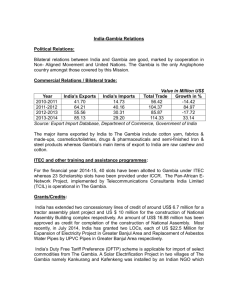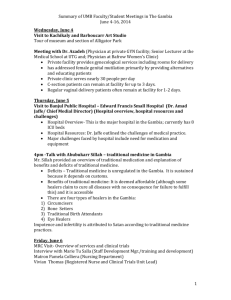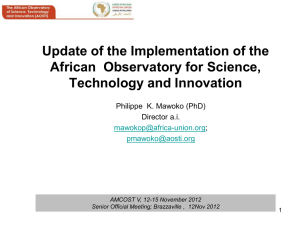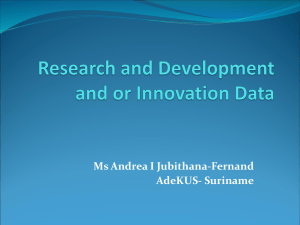REPUBLIC OF THE GAMBIA THE GAMBIA: DRAFT COUNTRY
advertisement
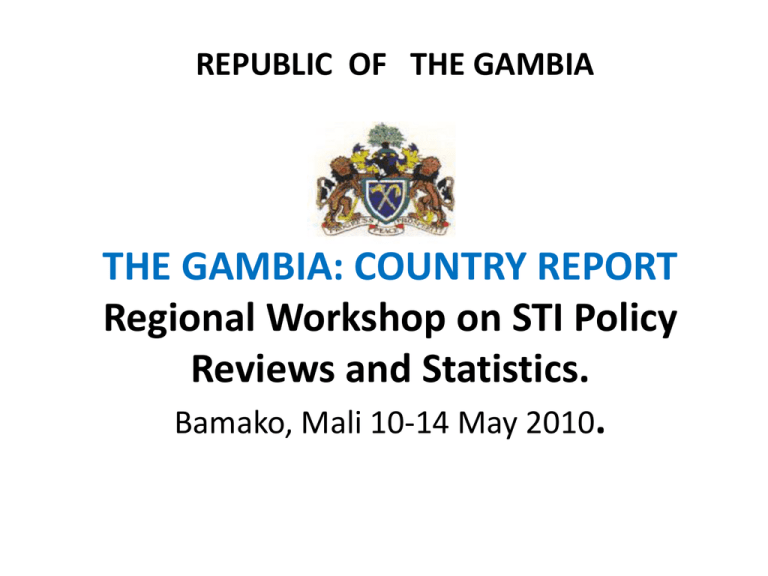
REPUBLIC OF THE GAMBIA THE GAMBIA: COUNTRY REPORT Regional Workshop on STI Policy Reviews and Statistics. Bamako, Mali 10-14 May 2010. 1) S&T Policy Report a) Main institution involve in S&T policy; function, mission and structure. The Ministry of Higher Education, Research, Science and Technology (MoHERST) is the main institution in the Gambia involve in S&T policy and related issues. The Ministry was created in February, 2007 and became operational in March, 2007. The Ministry is responsible for policy development, management and coordination of programmes and activities relating to Higher Education, Research, Science and Technology to ensure a more meaningful socioeconomic development of The Gambia. The mission statement of MoHERST is to provide relevant, sustainable and quality higher and tertiary education, research, science and technology to support socio-economic development, scientific and technological advancement, vocational and technical education. 2 The organizational structure of MoHERST The administrative staff of the Ministry currently on the ground are: • • • • • • • • • The Honourable Minister of MoHERST The Permanent Secretary Deputy Permanent Secretary Principal Assistance Secretary Assistant Secretary 1 Principal Private Secretary 1 Private Secretary 1 Senior Accountant 1 Accounts Clerk 3 Organizational structure cont. The technical staff currently on the ground are: • • • • • • Director Higher Education 1 Principal Higher Education Officer 2 Senior Higher Education Officers 1 Higher Education Officer 2 Research Officers 1 Science and Technology Officer 4 b) Main R&D funding institutions and mechanisms. In The Gambia expenses on R&D are not lump into one component as R&D but instead spread out using various nomenclatures as highlighted in the table below: Ministry Actual 2007 Approved 2008 Estimated 2009 Ministry of Works, Construction & Infrastructure D238,970:00 D3,090,000:00 D2,080,000:00 Ministry of Health & Social Welfare Nil Nil D365,000:00 Ministry of Fisheries & Water Resources D59,988:00 D80,000:00 D400,000:00 Ministry of Higher Nil Education, Research, Science & Technology D700,000:00 D700,000:00 Ministry of Energy Nil Nil D150,000:00 GRAND TOTAL D298,958:00 US$11,072.52 D4,370,000:00 US$161,851.85 D4,195,000:00 US$155,370.37 5 c) Main R&D performing institutions by sector: Government, Higher Education, Business enterprise and Private non-profit, and their relative importance. • The main R&D performing institutions by sector and their relative importance are: Institution Function National Agricultural Research Institute (NARI) Conduct research in crop and animal husbandry for improved crop varieties and animal breeds for food self sufficiency Public Health Research & Development Centre (CIAM) Engage in research focusing on priority diseases such as Malaria and HIV/AIDS International Trypanotolerant Centre (ITC) Involve in research in animal diseases control Medical Research Council (MRC) Involve in research in infectious diseases National Nutrition Agency (NANA) Specialises in public health nutrition research 6 d) Main institutions carrying out other S&T activities: S&T services; 1. 2. 3. 4. National Agricultural Research Institute (NARI), International Trypanotolerant Centre (ITC), Medical Research Council (MRC) Educational Research Network for West and Central Africa (ERNWACA) Higher Education; 1. University of The Gambia (UTG) e) Innovation systems. Organisations and sectors with their roles: This is not available; however government is encouraging organizational and institutional involvement in it as enshrined in its Vision 2020. 7 f - j) STI policy and policy framework The Gambia does not have a national STI policy. However, the government is committed to developing a national STI policy. In light of this, in February – March 2008, ISESCO in partnership with The Gambia National Commission for UNESCO (NATCOM) supported a consultancy on the preparation process for the Development of a Science and Technology Policy for The Gambia. The exercise attempted to identify and incorporate the sectoral policies and concerns on what a Science and Technology Policy for The Gambia should comprise based on the different challenges peculiar to each sector. In order to ensure that S&T features in the decision-making process, our S&T policy must be integrated into the overall development policies of The Gambia. Government, therefore should develop a national system of science governance, formulate strategies for science, technology and innovation and integrate these into national development plans and programmes. 8 k &l) Challenges faced by scientists and other related issues: All positive moves in The Gambia are yet to be backed by a National Science and Technology (S&T) Policy, an instrument widely recognised as having impact on a country's economic growth and prosperity. The non existence of a National Science and Technology Policy not only hinders our development plans but also creates a situation whereby we do not have a coordinated sense of direction as well as guidelines that can trigger research and development (R&D) in this country. This situation leads to the following challenges: • Very little investment in science, technology and innovation. • Low investment in R&D • The limited science and technology infrastructure, resources and capacity; 9 Challenges faced by scientists and other related issues: Cont. • Lack of critical mass of scientifically literate policy-makers or decision-makers who appreciate the link between science and technology and the socio-economic and socio-political issues to a level where they can commit costly and long-term investment as a matter of priority; • Lack of a critical mass of trained and motivated personnel, policies or appropriate incentives to retain the few Science and Technology personnel that exist within the system; • Lack of proper incentives and partnerships with the private sector to engage in a more strategic and long-term development of the human resource base; and • Absence of a formulated policy in some of the sectors. 10 2) S&T Indicators report i) S&T Indicators a) Are internationally comparable data used to inform the S&T policy discussions in your country? If yes, please briefly explain how they are used. If not, please explain why. No, they are not used. Because we do not have a national STI policy and are yet to set up a framework and a taskforce to guide our activities for the development of an STI policy. 11 S&T Indicators cont. b) Please describe your country’s priorities for S&T data/Statistics. The creation and establishment of a policy framework will guide our priority for data and statistics ii) Collecting R&D statistics a) Does your country produce R&D statistics and indicators? If yes, please provide a summary of the results of the most recent R&D survey, or provide us with a copy of your most recent publication. If not, please explain the reason for this, describing plans to do so in the future, and continue from iii). We do not have any national statistics on R&D and indicators. However the recent Mapping of STI Policy and Institutional Status in The Gambia, May –July 2009, funded by UIS (UNESCO Institute of Statistics) through the UNESCO Nairobi Office was able to tease out some data on STI and R&D. With the collected information, the MOHERST has been availed the opportunity to better organise its STI database and update it with new data. 12 S&T Indicators Cont. iii) Other S&T statistics a) Does your country collect innovation statistics? No. Because there is no national policy framework (which the government is committed to), institutions have their own polices and collect data but these data are divorce at the national level. However data is collected by institutions but is not shared at the national level. b) Is there any current or planned mechanism to track the careers of doctoral holders in your country? If so, please briefly describe it. No. There is no planned mechanism as such. 13

